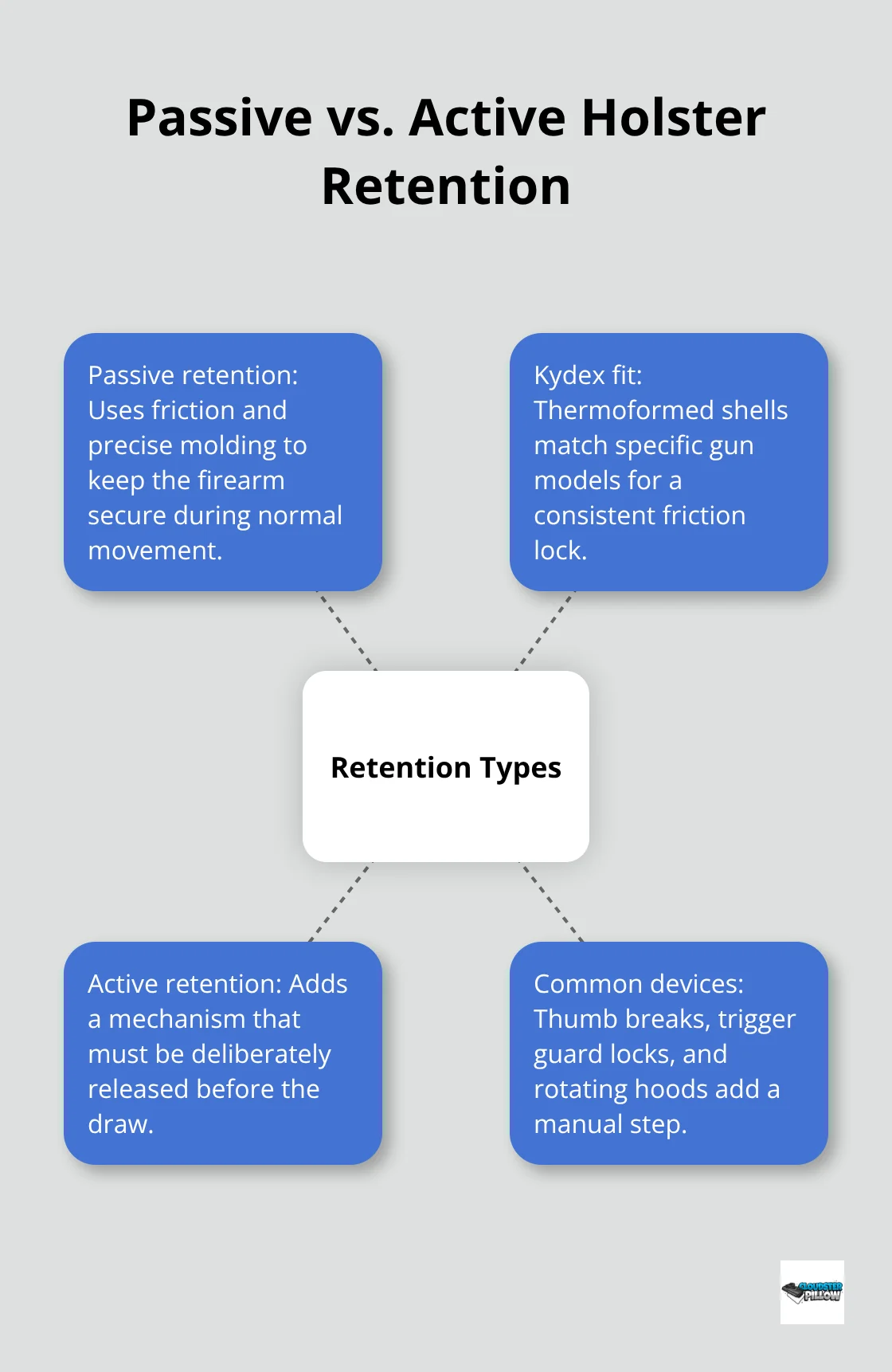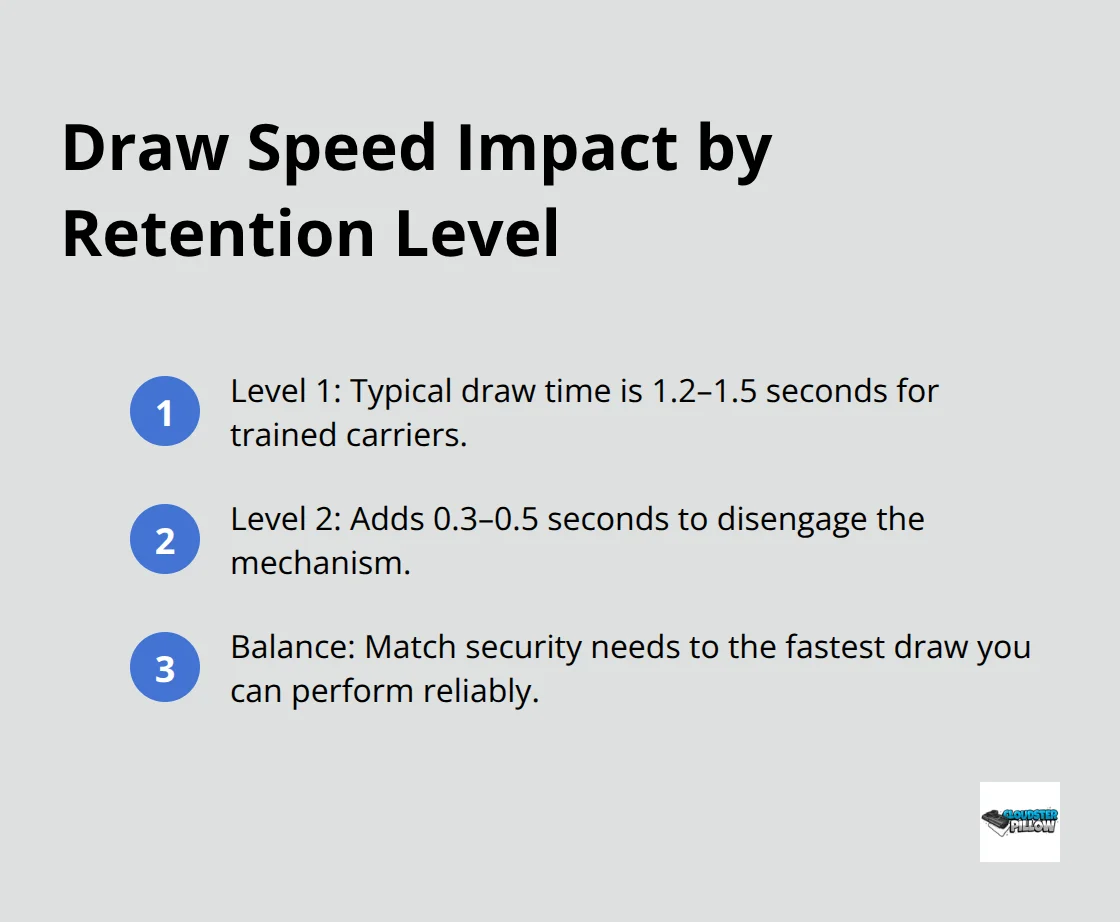Appendix Carry, Firearms
Understanding Holster Retention Levels for Concealed Carry
Holster retention determines how securely your firearm stays in place during daily carry. The wrong retention level can compromise both safety and accessibility when you need it most.
We at Cloudster Pillow see carriers struggle with this balance every day. Understanding retention levels helps you make informed decisions about your concealed carry setup.
How Does Holster Retention Work
Two Core Mechanisms Control Your Firearm
Holster retention operates through two distinct mechanisms that work independently or together. Passive retention uses friction between your firearm and the holster material to hold the gun securely. The holster holds the firearm through friction and precise molding, which creates natural resistance that prevents the weapon from falling out during normal movement.
Modern Kydex holsters achieve this through precise thermoforming that matches your specific firearm model. Active retention adds mechanical devices like thumb breaks, trigger guard locks, or rotating hoods that require deliberate manipulation to release the firearm.

Security Levels That Prevent Weapon Takeaways
Your retention level directly impacts weapon security during physical confrontations. Research shows that firearm disarmament incidents can occur when officers use lower-level retention holsters. Level 1 holsters work well for concealed carry because the firearm stays hidden, which reduces grab attempts.
Level 2 systems add one security mechanism that makes unauthorized access nearly impossible for someone unfamiliar with your specific holster. Most law enforcement agencies mandate Level 2 retention minimum for patrol officers. Higher retention levels prevent weapon takeaways during struggles but require extensive training to maintain muscle memory under stress.
Draw Speed Trade-offs You Must Consider
Each retention level demands different training commitments and affects your draw speed measurably. Level 1 holsters allow the fastest access with single-motion draws, perfect for concealed carriers who practice regularly. Level 2 systems typically add 0.3 to 0.5 seconds to your draw time while you disengage the retention mechanism.
Level 3 holsters can increase draw times by a full second or more without proper training. Law enforcement training protocols emphasize regular practice sessions specifically focused on retention holster manipulation. Your training schedule should match your retention choice-higher levels need more frequent practice to maintain proficiency when adrenaline peaks.
These timing differences become critical when you consider the specific retention levels available and their intended applications.
What Retention Level Fits Your Carry Style
Level 1 Passive Retention for Concealed Carry
Level 1 holsters rely exclusively on friction fit and precise molding to secure your firearm. These holsters work perfectly for concealed carriers because the weapon stays hidden from potential threats. Adjustable retention screws let you customize the clamping pressure to match your firearm and personal preference.
Most quality Level 1 holsters provide reliable retention force, which keeps your gun secure during normal daily activities while allowing smooth single-motion draws. Competitive shooters prefer Level 1 systems because they eliminate fumbling with mechanical releases during timed events.
The key advantage lies in simplicity-no moving parts means fewer failure points and faster muscle memory development. You can master the draw stroke quickly without worrying about additional mechanisms that might fail under stress.
Level 2 Active Retention for Open Carry
Level 2 holsters combine passive retention with one active mechanism like thumb breaks or trigger guard locks. Law enforcement agencies commonly require Level 2 systems for patrol officers. These systems typically add 0.3 seconds to your draw time but make weapon takeaways nearly impossible for untrained attackers.
Thumb breaks remain the most popular Level 2 mechanism because they engage naturally during your draw stroke. Trigger guard locks provide superior security (they automatically engage when you holster) and require precise finger placement to release.
Open carriers benefit most from Level 2 retention because their firearms stay visible and accessible to others. Training becomes essential-practice your draw stroke 50-100 times weekly to maintain proficiency with the retention mechanism.
Level 3 Systems for High-Risk Environments
Level 3 holsters incorporate multiple active retention devices and serve law enforcement in high-threat situations. These systems prevent weapon access during physical struggles but demand extensive training commitments. Officers typically practice Level 3 draws 200-300 repetitions monthly to maintain speed under stress.
Research has shown that weapon disarmament incidents can be reduced when departments implement higher retention systems. Most Level 3 systems combine automatic locking mechanisms with manual releases, requiring three distinct movements to access the firearm.
Draw times increase by 1-2 seconds without proper training, making these systems impractical for most civilian concealed carriers. Your choice of retention level must align with your specific carry environment and threat assessment to maximize both security and accessibility.
Which Retention Level Should You Choose
Your carry environment determines the retention level you need more than personal preference or training background. Concealed carriers face lower weapon grab risks than open carriers, which makes Level 1 retention the smart choice for most situations. States with less restrictive laws show increased firearm assault rates, highlighting the importance of proper retention systems. Level 1 systems provide adequate security while they maintain fast access speeds that could save your life during critical incidents.
Environmental Threat Assessment Drives Your Decision
Urban carriers who frequent crowded areas need different retention than rural carriers who spend time in low-population zones. Office workers who carry concealed can rely on Level 1 retention because their firearms stay hidden throughout the workday. Security professionals who work events or retail employees in high-crime areas should consider Level 2 systems despite slower draw times.
Your specific environment matters more than general recommendations-assess your daily exposure to potential threats and choose accordingly.
Training Time Determines System Effectiveness
Level 1 systems require 20-30 practice draws weekly to maintain proficiency, while Level 2 systems demand 50-100 repetitions to develop reliable muscle memory. Regular practice with retention systems prevents performance degradation during critical situations.

Level 3 systems need 200+ weekly draws to prevent fumbles during high-stress situations (most civilian carriers lack time for extensive retention practice). This reality makes Level 1 the practical choice for consistent performance. Match your training commitment to your retention choice-inadequate practice with complex systems creates dangerous hesitation when seconds matter most.
Balance Security with Accessibility
Your retention choice must balance weapon security against draw speed requirements. Level 1 holsters allow single-motion draws that take 1.2-1.5 seconds for trained carriers. Level 2 systems add 0.3-0.5 seconds to your draw time while they provide superior takeaway resistance.

Most concealed carriers benefit from Level 1 retention because the weapon stays hidden from potential threats. Open carriers face higher grab risks and should consider Level 2 systems despite the training requirements. Your personal threat assessment should drive this decision rather than following generic advice that doesn’t match your specific circumstances.
Final Thoughts
Your holster retention choice shapes every aspect of your concealed carry experience. Level 1 systems work best for most civilian carriers because they balance security with accessibility while they require minimal practice time. Your specific environment and threat assessment should drive this decision rather than generic recommendations.
Proper holster retention builds genuine carry confidence by preventing weapon loss during daily activities while it maintains fast access when needed. The wrong retention level creates hesitation during critical moments or provides inadequate security for your situation. Training commitment must match your retention choice (Level 1 systems need 20-30 practice draws weekly, while Level 2 systems demand 50-100 repetitions to maintain proficiency).
Your holster selection represents just one component of effective concealed carry. Comfort during extended wear affects your willingness to carry consistently. We at Cloudster Pillow understand that true carry confidence comes from systems that feel natural throughout your day, which is why our holster wedge enhances concealment and comfort for AIWB and IWB setups.

